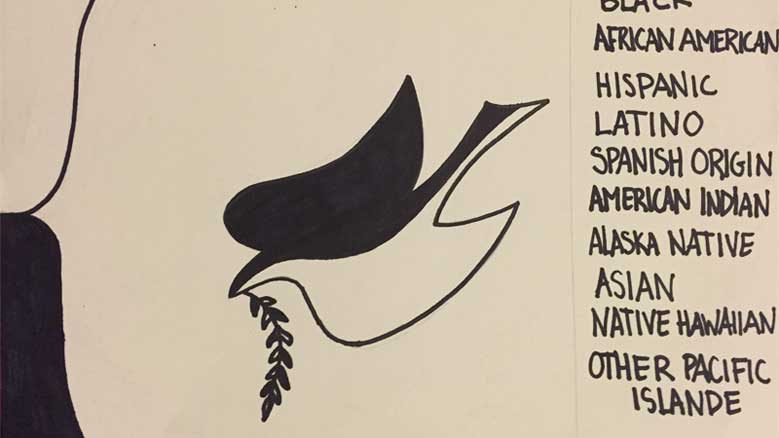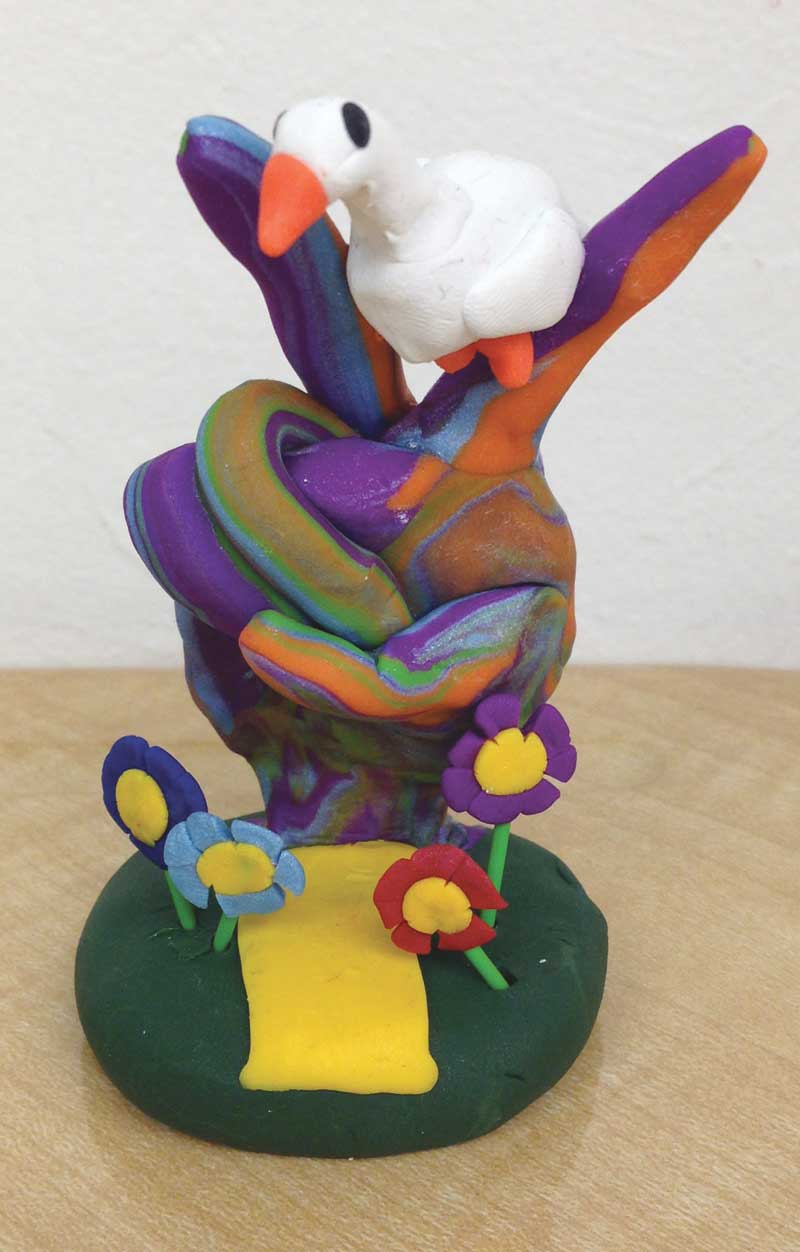(Part of the 2nd annual Student Voices Project)
Prompt: Respond to one or more of the following quotes.
“There is no way to peace. Peace is the way.” —A.J. Muste
To Make Peace, We Must Work Together
Georgia Condon, Grade 6, Greene Street Friends School
I appreciate and believe this quote. Muste’s idea is on a flag outside of my school, and I always think about it. You can’t just find peace, as if it were a person or an object. It won’t be sitting under a rock or hiding in a corner. Peace is something that you have to make. You have to compromise to make peace. You may not get everything that will make you happy. Sometimes you have to use other’s ideas, if it is what’s good for the group. You have to stand for what you believe in, but do it in a way where people agree and disagree fairly. For example, when you are sharing your idea, you have to let others share their thoughts, even if they are different from your thoughts.
There Is No Way to Peace
Celie Kaplan, Grade 7, Carolina Friends School
These six words are telling us that throughout history humankind has been running and running and running, and now that we have finally reached the end of this race, it turns out that the grand finish line, with food, friends and family, joy, and a big trophy isn’t here. There is only the edge of a cliff.
As we have been running and running and running toward peace, we have tried other ways, shortcuts to the finish line, and the shortcuts took an incredibly wrong turn that led us to the cliff. These shortcuts to peace have involved guns and many other forms of weaponry and violence. For generations, we have taught our children that violence and war will get us what we want and “need.” In some cases, it has been true that violence became the only way, but even in those cases, violence seemed necessary because it was provoked by violence. Violence has only caused society to spiral downward. Who knows what might happen if we don’t put a stop to the constant violence taking place around us?
As we try to stop ourselves, we have to help the next generation. While it may be too late for our generation and our parents’ and grandparents’ generations, we can help our future children to create a better world for themselves. We can teach them that violence is not the answer. We can teach them that there are so many better ways to solve conflict in the world around us. We can teach them to take the true route, not the shortcut.
“Peace cannot be kept by force; it can only be achieved by understanding.” —Albert Einstein
Equiano Hunter, Grade 7, Germantown Friends School
This quote really describes any and all conflict throughout history. In Ferguson, Missouri, and Staten Island, New York, police officers are delivering an overdose of force and violence, killing dozens of black men, but they believe that they’re “doing their job,” and are trying to keep the peace. You cannot keep peace through violence because peace and violence cannot exist in the same place at the same time. Nonviolent protestors protest against these recent “homicides,” believing that violence will only provoke more conflict. Police officers meanwhile gas them, put on gear as if they’re preparing for a terrorist attack, and arrest them for doing nothing but standing out in the middle of the street, hefting signs, and shouting against this injustice.
Where the Great White (Privilege) Lay
Emmanuelle Ward, Grade 11, Tandem Friends School
There is a sea of injustice,
I am watching from the shore.
Until I have tasted the ocean spray,
And felt the waves crash upon me,
I can say nothing more.
As a white person, I’ve never been discriminated against. I have never felt fear when around an officer—paranoia maybe but never genuine fear. White privilege is a concept that seems to be hard to grasp for many of us, but we must use it to put the spotlight on people of color when they are speaking out about this and realize we have no right to speak over them about an issue we know nothing about.
“If you want to make peace with your enemy, you have to work with your enemy. Then he becomes your partner.” —Nelson Mandela
Madison Sings, Grade 6, Newtown Friends School
To me, this quote means that no matter who your enemies are, the way to make them allies is through peace and resolution, not conflict. You might not have the same opinions, but there is always a choice whether or not to fight. The best reward for working together is peace, and once that is realized, war will cease to exist, and the earth will be a peaceful and serene place to live.
Together
Maddi Stewart, Grade 6, Sidwell Friends School
Conflict has affected so many lives in the Middle East for a long time. It’s been non-stop wars that have torn apart so many friends and families. The United States and many other countries like China and Russia have tried to help the Middle East, but they have rejected their help. Maybe it’s because they want and believe that they can solve this all on their own. But that’s the thing, the reason why we are having so many conflicts in the world is because nobody is working together.
This quote really speaks to me because it says exactly what the world needs to do. Especially in the places where there is non-stop conflict like the Middle East. They need to join together as communities and countries and put a stop to this. People’s homes have been destroyed by war and conflict, and what was once a safe, tight-knit neighborhood in Syria has been struck by war and hatred.
People have been trying to stop the conflicts in the Middle East for years now. But you can never stop conflict, no matter how hard we try. There will always be that one person or group of people that hates anyone and everyone because of their differences. We need to put them out of our minds and focus on the things that matter. We have so many good and intelligent people in the world. Just imagine what it would be like if everybody worked together.
“One has to fight for justice for all. If I do not fight bigotry wherever it is, bigotry is strengthened.” —Bayard Rustin
Julian Craig, Grade 6, Sidwell Friends School
To be completely honest, I never really used to think about peace and justice. It was not until I was ten that I realized that not everyone was treated fairly. I saw that in some countries there are dictators that do not give people all the resources or rights they deserve. I would be lying if I said that there is not injustice everywhere we go. I love this quote from Bayard Rustin because it tells me I always need to fight injustice no matter how small.
I hope that this makes someone realize that something has to be done. If I ignore the little things, then when bigger things occur I will ignore them too. Think of where the world would be if no one ever spoke up against injustice. Now, think of where the world will be if no one ever speaks up for justice again. If everyone waited for someone else to speak up, we would get nowhere. We have to start somewhere, right? So why don’t we start with ourselves?
“At the center of nonviolence stands the principle of love.” —Martin Luther King Jr.
Why Do We Have Conflict?
George Wilson, Grade 6, Sidwell Friends School
Since my mother works in the business, I have been watching the news for as long as I can remember, and have seen stories of all kinds. I became interested in why people would do these things. Since this kind of thing was on the news almost every single day, I began to try to answer my question. I had heard about many different types of conflict: the war on the Taliban, the Boston Bombing, and of course 9/11. With each one I have always wondered how people would kill just because of, well, differences.
Sometimes it isn’t about differences. People want money, and others imagine a world where only their race rules. To me, peace is more than not fighting. To me, a peaceful world is a safe world. It is a world where everyone is accepted. It is a world where no one is cast out because of being homosexual. No one is discriminated against because of their skin color. No one is bullied, and differences are resolved, a place where it is okay to be yourself: a loving, conflict-free world. As the great Martin Luther King Jr. once said, “At the center of nonviolence stands the principle of love.”
Love is part of peace. As this quote states, nonviolence and love are connected as are nonviolence and peace. These three combined together become true peace. True peace is very hard to achieve, for it is not enough to achieve peace on the surface; you must achieve peace from within by accepting people’s differences.
George Wilson plays many sports and lives with his mom, dad, brother, sister, and dog. He likes to spend his free time at the park playing basketball or playing with friends. When he grows up he would like to be a lawyer, an advertising executive, or a writer.
Nonviolence and Love: Is There a Connection?
Annie Rupertus, Grade 6, Greene Street Friends School
I’m not technically Quaker, but I’ve been going to a Friends school for over six years, so I kind of feel as if I’ve developed an “inner Quaker.” All the Quaker testimonies that we celebrate and practice—simplicity, peace, integrity, community, equality, and stewardship—are stored there. I feel like that part of me, where everything I’ve learned about Quakerism lives, sort of mentally highlighted this quote.
When I read this, the first thing that popped into my head was an image of a circle with a big heart in the center. It helped me to understand the quote when I visualized the object (love) as a literal object in the middle of nonviolence. This image raised a lot of questions for me. Some of the answers are very unclear. It’s tricky. For example, if love is part of nonviolence, is nonviolence love? I love my brothers, but sometimes we wrestle for fun at home (not the most Quakerly exercise, but it’s true). If I’m not fighting with a friend, does that mean I love them? Is it possible to have nonviolence without love? If two sides compromise and work together while some people still have hostility toward the other group, is that nonviolence, even if they aren’t fighting? And is love nonviolence? Again, I love my family, but we argue. We’re not violent in a literal sense, but does it count if we have verbal fights? I guess it depends on how you look at it. If you interpret the quote as more of a metaphorical statement, you might define nonviolence as working together and loving your partner at the same time, as opposed to not physically fighting. If you take it literally, it might not make as much sense unless the situation in mind has people who don’t fight and love each other.
This comes full circle to a previous question: can there be nonviolence without love? That also depends on perspective. The dictionary defines nonviolence as follows: (1) absence or lack of violence; state or condition of avoiding violence; (2) the policy, practice, or technique of refraining from the use of violence, especially when reacting to or protesting against oppression, injustice, discrimination, or the like.
At least according to the dictionary, I’m on the right track in defining nonviolence as the opposite of violence. If that’s how Dr. King thought of it when he said this, maybe it’s love I should think about differently in order for the quote to make more sense. So far, I’ve been thinking he means that at the center of nonviolence is love for the people you might fight with. This isn’t exactly parallel to the example I explained earlier, where two sides compromise and work together but still don’t share any love for each other. He might have meant love for yourself or love for your allies instead of your enemies. Maybe he means that the center of not being violent is a love for yourself and a will to survive. Or it could be a love of the friends who might follow you into the battle and get injured, physically or mentally. I don’t enjoy seeing anyone in pain, especially people I love. All in all, I think the meaning and truthfulness of this quote depends on your perspective, and a lot of the questions mentioned earlier may or may not have answers, depending on how you look at it.
Annie Rupertus lives in the Mount Airy neighborhood of Philadelphia, Pa., with her parents, sister, two brothers, and bunny, Sambuca. Her favorite subject is music. Some of her favorite activities are reading, drawing, singing, and hanging out with family and friends.
Explore the other prompts from the 2nd annual Student Voices Project:
Story Time – Ponder – Get Involved – Imagine – Visual Arts – Photography





Comments on Friendsjournal.org may be used in the Forum of the print magazine and may be edited for length and clarity.